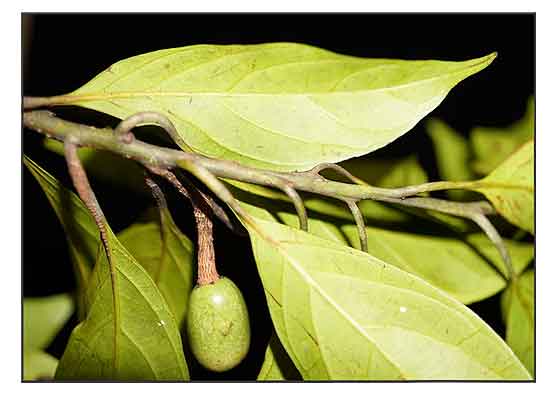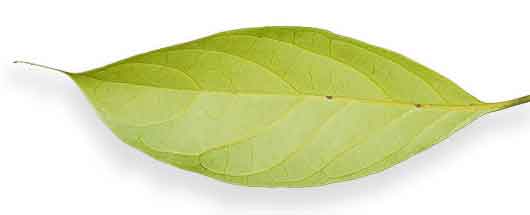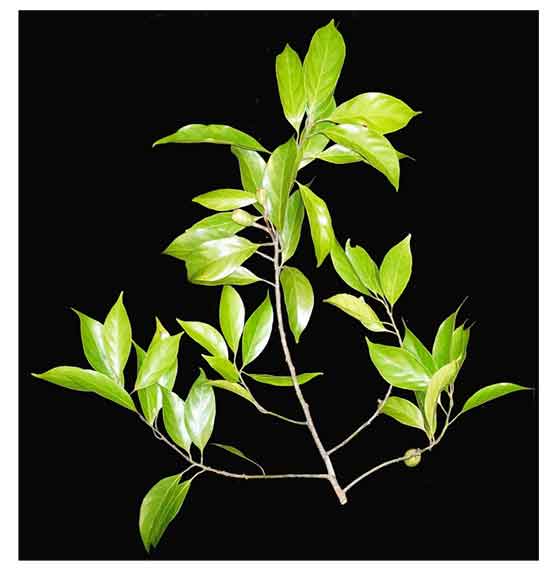 Gen info Gen info
-
Nothaphoebe umbelliflora is an evergreen tropical tree in the family Lauraceae, which contains 21 species. It was first described by Carl Ludwig von Blume in 1851.
- Etymology: The genus name Nothaphoebe derives from Greek words nothos, meaning "false" and phoebe, referring to the close resemblance to the genus Phoebe. The species epithet derives from Latin umbellatus, referring to the tree's flowers forming an umbel, i.e., the flower stalks all arising from the same point. (2)
- The bark is the main source of commerce. The tree is usually cut before the bark is peeled off the trunk.
- The red Gemor
- Note: There is a confusing use of "red gemor" and "white gemor" for Nothaphobe umbelliflora and N. coriacea. While both colors are used for N. umbelliflora, more often than not, it referred to as "white gemor".
- Red Gemor (Nothaphoebe ciriacea Koserm) has a yellowish red color after being peeled; the white Ge,pr (N. umbelliflora) has a white coloring on the bark. (7)
Botany
• A tree up to 33 m tall. Foliage: Alternate, subopposite, or opposite stalked leaves have leathery leaf blades that are oval to oblong or drop-shaped, 6–17 by 2–6 cm, and with tapered and sometimes asymmetrical bases. Flowers: Flowers are yellow, covered with hair, and found in clustered in much-branched shoots at the leaf axils. Fruits: Oblong fruits are 3 by 1 cm when dry, shiny green to reddish or black when ripe, and have pink stalks. (3)
• Medium-sized to large tree to 33 m tall; trunk girth to 300 cm. Bark grey or grey-brown, smooth to faintly dippled or scaly, lenticellate, inner bark yellow-brown, mottled, fragrant, sapwood yellow. Young twigs often drying black, growing tip and young leaves with fine golden hairs; trunk base slightly fluted. Leaves alternate, sometimes subopposite, rarely opposite; blade often drying dark brown or almost black, elliptic, often narrowly so, 7.5–19.5 × 3.5–6.5 cm, coriaceous to chartaceous, glabrous, with midrib raised above and below, secondary nerves raised above and below, 5–7 pairs, looping near the margin, and tertiary veins scalariform-reticulate, distinct above and below, apex attenuate, base narrowly cuneate to attenuate, sometimes disjointed; stalk often drying black, slender, drying 1–1.5 cm long. Fruit ripening reddish, oblong, 3 × 1 cm when dried; stalk pink. (5)
 Distribution Distribution
- Native to the Philippines.
- Also native to Borneo, Cambodia, Jawa, Laos, Lesser Sunda Is., Malaya, Maluku, New Guinea, Sulawesi, Sumatera, Thailand, Vietnam. (1)
- In primary and secondary rainforests, including lowland and upland mixed dipterocar[p and riparian evergreen forests, from sea level to 1200 m elevation. (2)
- In Laos, once abundant, now endangered, victimized by slash-and-burn clearing of forests for rice production and the commercial use of bark.(2)
Constituents
- Phytochemical analysis of leaves (L), twigs (T), and bark (B) revealed: flavonoids (L+++, T++.B++), alkaloid (L++,T+,B+), steroid (+), triterpenoid (+), phenolics (L+++. T+,B++). (see study below) (4)
- The viscous bark yields laurotetanine, a toxic alkaloid.
Properties
- Study suggested anti-inflammatory property.
 Uses Uses
Edibility
- No report on edibility found.
- In Indonesia, seeds reportedly consumed by orangutans.
Folkloric
- No reported folkloric medicinal use in the Philippines.
Others
- Gum and oil: The bark contains gum and aromatic oils. Pulverized bark is used to make incense sticks for temples in South and Southeast Asia. It is also used as ingredient of mosquito coils and glue for carton and particleboard. Mixed with soil, the bark is material for molding statues and household items. (2)
- Bark: The bark is sun-dried by farmers and sold to factories, where it is ground and mixed with sawdust and perfumed talk to make a mix called kobuac. Bamboo sticks are rolled in this compound and dried to make incense or joss sticks. (2)
- Wood: Used for house construction.
- Insecticide: Bark contains a toxic alkaloid, laurotetanine. Used as insecticide and production of joss sticks and insect repellent coils. (5)
Studies
•Anti-Inflammatory: Study evaluated the anti-inflammatory effect of different parts of the red gemor by inhibition protein denaturation method. Percentage inhibition varied from 20.154 to 71.667. IC50 2qw 60 for the twig, 47.8 bark, 116.2 for leaves. Anti-inflammatory activity of different parts of red gemor was attributed to phytochemical constituents, such as flavonoid and alkaloid. Linear correlation between IC50 and alkaloid and flavonoid content showed the flavonoid with most influence to protein denaturation. (see constituents above) (4)
Availability
Wild-crafted.
|

![]()



 Gen info
Gen info

